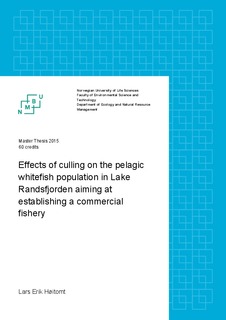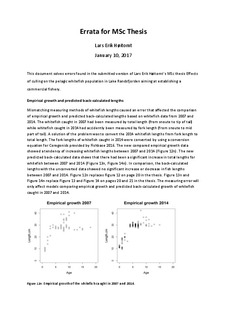| dc.description.abstract | The fishery in Lake Randsfjorden has long traditions, and especially the European whitefish Coregonus lavaretus has earlier played an important role as additional food supply for local communities in the area. After a rapid decrease in the exploitation of whitefish in the late 1980s, the population became overcrowded and stunted. The high infection intensity of the tapeworm Triaenophorus crassus became a particular problem as this parasite encyst in the whitefish flesh and makes the fish less attractive for human consumption. In 2007, hydroacoustic-, gillnet- and zooplankton surveys were conducted in Randsfjorden examining the conditions of the whitefish stock and opportunities for establishing a commercial fishery. The conclusions were that the whitefish stock was overcrowded, strongly infected by T. crassus and needed considerable improvements before a commercial fishery could be established. Based on information from this survey, an intensive culling programme using trap nets and shore seines was initiated the same year aiming at increasing the quality of the whitefish stock.
In 2014, after seven years of intensive culling, a new survey using same methods as the 2007-survey was conducted with purpose of examining the effects of the culling programme and providing recommendations for further actions in the lake.
Due to low gillnet catches and hydroacoustic surveys less suitable for comparison, it became difficult to arrive at a reliable conclusion concerning changes in whitefish density between 2007 (4.6 kg/ha, daytime survey) and 2014 (13.3 kg/ha, night survey). However, a hydroacoustics time series from Randsfjorden indicated a long term decline in biomass density since early 1990s up to present. The age composition of whitefish in the lake had gone through significant juvenilisation compared to 2007. However, the whitefish showed few improvements in growth as annual growth rates and stagnation lengths were the same as found in 2007. The infection intensity of T. crassus had slightly improved since 2007 with an overall reduction in number of parasites pr. fish. However, the parasite was still a major problem in Randsfjorden as 90 % of the whitefish were found to be infected. The composition of the zooplankton community did not corresponded with the high infection of T. crassus as the first intermediate host Cyclops scutifer occurred in a very low number in the zooplankton samples.
The intensive culling programme needs extensive improvement and new strategies in order to increase whitefish growth. New and more efficient fishing gears should be developed for a more efficient removal of whitefish. The density of smelt Osmerus eperlanus and roach Rutilus rutilus had significantly increased since 2007, and their possible interactions with whitefish need further attention. A more comprehensive sampling of the zooplankton community is required in order to attain more knowledge about the transmission of T. crassus between pike Esox lucius, C. scutifer and whitefish in Randsfjorden. This knowledge may be valuable when developing new strategies in order to handle the parasite. In other lakes, removal of pike has shown positive results in reducing infection intensity of T. crassus in whitefish. Extensive pike removal should therefore also be considered for Randsfjorden. The whitefish stock in Randsfjorden needs further improvements before a commercial fishery can be established. | nb_NO |


